#national disc jockey day
Explore tagged Tumblr posts
Text
01/20/2025 is Blue Monday 🌎, Martin Luther King Jr. Day 🇺🇸, National Buttercrunch Day 🇺🇸, National Disc Jockey Day 🇺🇸, National Cheese Lovers Day 🧀🇬🇧

#blue monday#martin luther king jr day#national buttercrunch day#national disc jockey day#national cheese lovers day
12 notes
·
View notes
Photo
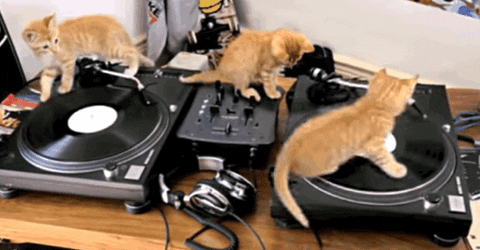
(via GIPHY)
#giphy#music#dj#cats#disc jockey#music streaming#national disc jockey day#national disc jockey#disc jockey day
11 notes
·
View notes
Text

Happy National DJ Day! I’m DJ Miss Milan and I’ve been spinning professionally for almost 8 years now and I completely love what I do! I’m grateful for this journey to provide the vibes worldwide!
#djmissmilan#music#dj#national day#christian faith#musica#musician#faith#faith in god#jesus christ#jesus#rnbmusic#rap hiphop#caribbean#afrobeats#amapiano#disc jockey
7 notes
·
View notes
Text
After being a husband and a father, my journey as a DJ has been one of the greatest joys of my life. Happy National Disc Jockey Day! 🎧🎶🎤

0 notes
Text
ELVIS' DEBUT ON TV — 📺 [CBS] The Dorsey Brothers 'Stage Show'
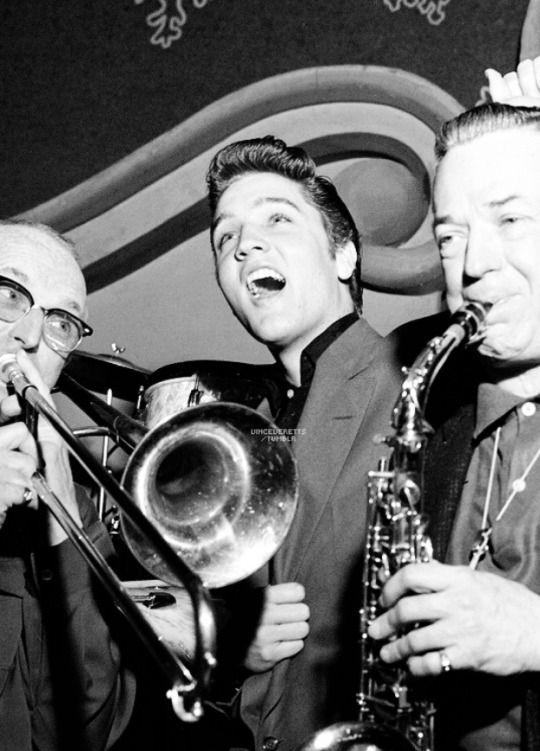
Elvis with Tommy and Jimmy Dorsey at CBS Studio 50, New York, March 17, 1956 [that would be Elvis' 5th appearance on their TV show, out of 6 total.].
------------------------------------------------------------------------------------------------
By December 1955 Elvis had still not made an appearance on national television. His manager Colonel Tom Parker negotiated a deal through Steve Yates with CBS's "Stage Show" for four appearances on the show in January 1956 at $1,250 each and an option for two more at $1,500 each.
On the January 28, 1956, Elvis was broadcast for the nation for the very first time, performing "Shake, Rattle and Roll", "Flip, Flop and Fly" and "I Got a Woman".
youtube
[ABOVE: the January 28th 1956 FULL PERFORMANCE]
On Elvis' first appearance on American television, Bill Randle, one of the most influential disc jockeys of the time, was the man who actually presented Elvis Presley to the nation. He said:
"We'd like at this time to introduce to you a young fellow, who like many performers, Johnnie Ray among them, come up out of nowhere to be overnight very big stars. This young fellow we met for the first time while making a movie short*. We think tonight that he's going to make television history for you. We'd like you to meet him now - Elvis Presley. And here he is!" — Bill Randle, Disc Jockey, the man presenting Elvis Presley to America for the first time. January 28, 1956.
After this, things would never be the same, specially the society. Such a good beginning for a year, that special day in a January month! ♥
------------------------------------------------------------------------------------------------
🎞️THE SHORT-FILM THAT NEVER SAW THE LIGHT OF DAY (for the general public... at least until now...)
The movie short Bill Randle referred to during his introduction to Elvis was "The Pied Piper Of Cleveland - A Day In The Life Of A Famous Disc Jockey" a short film made by Universal pictures about Bill Randle himself. Filmed on October 20th, 1955, at a concert in Brooklyn High School, Cleveland, it featured the stars Bill Haley & The Comets, The Four Lads, Pat Boone, plus the addition of a little-known Elvis Presley.
The original forty-eight-minute film was supposed to be cut down to a twenty-minute "short" for national distribution, but never made it that far. We're in 2024... 69 years went by since this shortcut was produced but the movie remains unreleased.
There is some dispute over whether or not this film actually exists, although it's said it was shown publicly, albeit only once in Cleveland, and excerpts were also aired on a Cleveland television station in 1956. Marshall Lytle, bass player for Bill Haley's Comets, corroborates the existence of the film in his memoir, "Still Rockin' Around the Clock", but he makes the unsubstantiated claim that Colonel Tom Parker, Presley's manager, bought the film and destroyed the existing copies. According to historians, tho, DJ Bill Randle, before his death in 2004, sold the rights to the film to PolyGram (it has been reported that Universal Studios has the negatives of the film in its vaults).
Much uncertainty about this short film, but can you imagine this film being release in Elvis' birthday centenary celebration? We watched, and listened, on Elvis' 89th birthday a few days earlier this year, to them playing during his birthday celebration at Graceland the original "That's All Right" record as it was cut at Sun Records studio in 1954, so who knows? There's always rare things surfacing here and there, so... we better keep our hopes this Bill Randle's 1955 movie, with some new 'baby Elvis' footage, will be release any day now [such as we know there's 'Elvis On Tour' and 'Elvis: That's the Way It Is' never seen before footage coming our way, as confirmed by the "Elvis" 2022 biopic's film director, Baz Luhrmann — finally! We hope it will be released soon].
------------------------------------------------------------------------------------------------
But enough daydreaming... Back to Elvis' 1st television appearances.
After the premiere on America's television on January 28th, 1956, Elvis would do five more appearances on 'The Dorsey Brothers Stage Show" for the next eight weeks. Those would take place on February 4, February 11, February 18, March 17 and March 24th, 1956.
------------------------------------------------------------------------------------------------
February 4th, 1956 | "Baby Let's Play House" and "Tutti Frutti"
youtube
youtube
------------------------------------------------------------------------------------------------
February 11th, 1956 | "Blue Suede Shoes" and "Heartbreak Hotel" *
youtube
youtube
* This is a special arrangement for 'Heartbreak Hotel', so good! Jazzy, dramatic, really rarity. I loved this! ♥
------------------------------------------------------------------------------------------------
February 18th, 1956 | "Tutti Frutti" and "I Was The One"
youtube
youtube
------------------------------------------------------------------------------------------------
March 17th, 1956 | "Blue Suede Shoes" and "Heartbreak Hotel" *
youtube
youtube
* This is the usual arrangement for the "Heartbreak Hotel" song. On February 11th, 1956, Elvis performed this same song onstage of 'The Dorsey Brothers Show' but it sounded something more… dramatic (I guess it matched the lyrics after all, but I love the usual arrangement better yet).
------------------------------------------------------------------------------------------------
And the last one... the 6th appearance on 'Dorsey Brothers Stage Show':
March 24th, 1956 | "Money Honey" and "Heartbreak Hotel" | [FULL PERFORMANCE]
youtube
------------------------------------------------------------------------------------------------
We can see how on those first TV shows Elvis still looks quite shy. Although he moves the usual lot, he doesn't flirt with his audience as much as he would on the upcoming TV appearances (and throughout his life, actually). It's funny how he grew comfortable with being in front of the cameras so fast tho. As his photographer Wiliam Speer said, "I guess you must really like being photographed."
------------------------------------------------------------------------------------------------
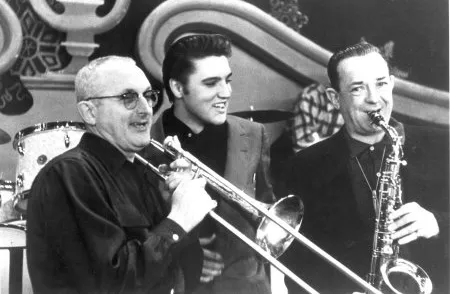
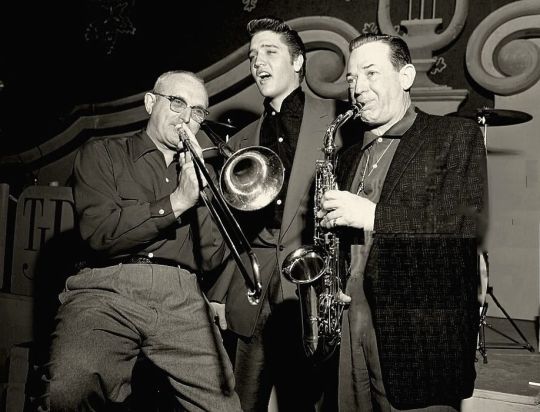
Elvis with Tommy and Jimmy Dorsey at CBS Studio 50 in New York, on March 17, 1956. That would be Elvis' 5th appearance on their TV show. 'The Dorsey Brothers Stage Show' (CBS) was the place Elvis debut in his TV appearances, on January 28th 1956. He would appear on the show for 6 times total, from January to March 1956. ♥
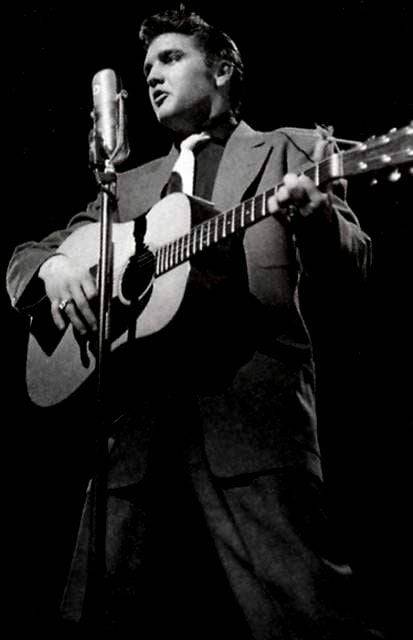
Performing on the 'Dorsey Brothers Stage Show' at the CBS Studio 50, New York City, on March 24th, 1956. His 6th and final appearance on the show.
------------------------------------------------------------------------------------------------
EDIT: THE BLUE MOON BOYS
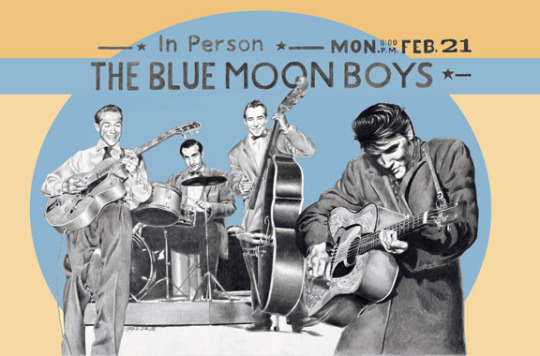
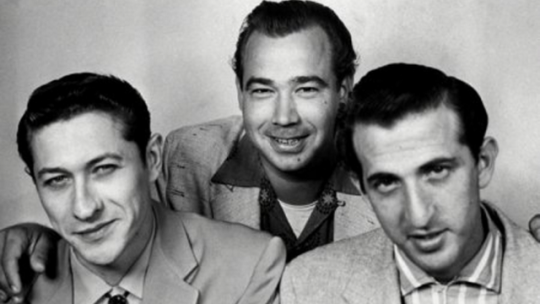
I hate it when I forget to mention such important, trivial, facts — and this shouldn't be footnote info and I feel guilty it is now but I forgot mentioning — The Blue Moon Boys. I love them so much! I watch those footage looking at them as much as I look at Elvis.
Like, I love Bill Black's energy onstage! I love him hollering, vibing to their sound, as loud as Elvis (on occasion). I love how he seem to love chewing gum (Bill is chewing gum in some of those footage), because it makes me look at the Blue Moon Boys and Elvis as a unit, real close friend who look alike, just how it should be. We know although EP for obvious reasons can't chew gum while singing, he loooooved gum and kept this - should I say "habit?" - throughout his life. It's sounding silly what I'm saying, I know, but I think this Elvis habit in fact date from back when he was rocking onstage with Bill, Scotty and DJ Fontana and it makes my heart warm how close and similar they seem to be, as friends, real friends. Bill is actually said to be the one cheering the crowds onstage when they first begun performing, when Elvis was still learning how to be the great leading man he became. When EP was still learning how to act onstage, how to manipulate the audience, creating the mad passionate reactions he learned to create whenever he wanted, Bill was the one heating things up, joking with the audience, cheering, hollering. Bill is amazing! His energy is intoxicating, and we can see it clearly on those first TV appearances performances. ♥
--
I also love how hot Scotty Moore looks! I kinda laughed thinking 'Oh my goodness' ... So this thing about rock and roll bands always having hot vocalists and hot guitar players as a rule, it looks like it all started from the 50s with EP and Scotty! (really, at least the singer and guitar player in most rock bands are hot AF, am I lying? *lol*). I have a thing for Scotty... When he smiles at times on those footage, I'm like: 🤤🥹🥴🫠 And I also love how he's elegant but at the same time menacing looking holding and playing his guitar like the guitar hero he was. Really, if you haven't yet, do yourself a favor and read Scotty's book "THAT'S ALL RIGHT, ELVIS: The Untold Story of Elvis' First Guitarist and Manager, Scotty Moore", by Scotty as told to James Dickerson (1997). Scotty's life story is fascinating and as interesting as Elvis'. ♥
--
And last, but never least, I love how together, calm and concentrated DJ Fontana looks. Ok, unfortunately being the drummer has it's disadvantages. We can't see DJ Fontana as much as we see the other boys onstage, but I listen to the songs until the very last minute and it's amazing how the music always has the closing, the important and dramatic ending, done by DJ's talented hands. I love that guy. ♥
Elvis Presley and The Blue Moon Boys were the best rock and rollers! I love their energy together. As much as I adore 70s Elvis onstage, the TCB Band, the Sweets Inspirations and all, if I only had one performance of Elvis' I could attend, just one to choose, I would go for - undoubtedly - the 50s ones, when those guys, The Blue Moon Boys and Elvis, were playing together.
That's Rock and Roll royalty. ✨👑 ♥
------------------------------------------------------------------------------------------------
There you go. All the videos together so you can watch of them easily. ♥
#elvis for the first time on America television#imagine seeing this baby for the first time out of the blue and then watching him skyrocketing in less than a year...#and then testify as he only grew bigger and bigger and even when he's no longer walking in earth how people still love him#man how I wanted be an old lady just because i would have lived and breathed Elvis Presley 🥹#all i can do is imagine#elvis the king#elvis#elvis presley#the blue moon boys#bill black#scotty moore#DJ fontana#Youtube#elvis fans#elvis fandom#elvis history#50s elvis#tv history#tv shows
88 notes
·
View notes
Text
Good morning. 🌿🌿🌿
20 January 2025

Hurray for today! It's Martin Luther King Jr. Day, a national holiday. Hmmm … there is something else important going on today … Oh, it's also National Cheese Lover's Day, National Buttercrunch Day, and National Disc Jockey Day. Unfortunately, you won't get a day off for the last three. One last thing about today—it's very much Monday. It's not Groundhog Day, though, but if it were, the groundhog probably wouldn't come out.
It's cold outside this morning—24°F, which is quite chilly for Louisiana but not so much for Minnesota, where it's 12°F in the Twin Cities. It's all about perspective. What feels like a cozy winter's day to one person can be a chilling experience for another.
"When life gives you Monday, dip it in glitter and sparkle all day." - Ella Woodward
9 notes
·
View notes
Text

#DJmonday Jimmy Youngblood did the morning show on WPAD in the 1950s and then switched to WDXR in the 1960s, where he broadcast through the early 1970s. Both stations are located in Paducah, Kentucky. Youngblood, often called "J.Y.," was the area's longest-running radio personality. In the late 1950s, he was chosen as one of the top twenty radio disc jockey personalities in the nation by Movie Mirror magazine. (The Paducah Sun, 8/9/1967).
"In addition, according to the Arbitron rating system, his show reached listener ratings so high that it has never been equaled before or since. More than 62% of the listening populace was tuned into Jim Youngblood's broadcast every day." – "Jim Youngblood: The Radio Icon," by Per Jensen
Special Collections in Mass Media and Culture | Tumblr Archive
9 notes
·
View notes
Text

President Andry Nirina Rajoelina (born May 30, 1974) in Antsirabe, Madagascar. His father, Roger Yves Rajoelina, was an army colonel. No information is available on his mother. He decided not to pursue higher education but instead to become an entrepreneur. He became an event organizer and promoter. He launched Injet, a digital printing company.
He purchased a television and radio station and became a well-known disc jockey. He decided to enter politics. He was elected mayor of Antananarivo (2007). He and the President of Madagascar became political competitors. In 2009, street demonstrations broke out against President Ravalomanan. He supported the demonstrators and accused the central government of the misappropriation of funds. He described the government as a dictatorship and used his control of many media outlets to broadcast his views. A group of the military organized a coup and he was made President of the High Transitional Authority of Madagascar (2009-14).
In 2014, a presidential election was held. He was barred by the new constitution from running but the candidate he endorsed won the election. He was on the ballot in the 2018 presidential election along with 47 other candidates. He won having garnered 55% of the votes cast after the second vote.
Over 75% of the population lives below the international poverty line of $1.90 per day. Madagascar has the 4thhighest rate of chronic malnutrition in the world and food insecurity is a major issue. In 2021, a famine impacted one million of the 29 million in the nation. On July 22, 2021, an unsuccessful assassination attempt was made on his life and in February 2022 cyclone Batsira swept over the island displacing 120,000 people and damaging 124,000 homes.
He has been criticized for spending government funds on vanity projects such as sports stadiums. Illegal logging of rosewood and other rare trees has occurred in some parts of the country. COVID-19 has negatively impacted the tourist industry and resulted in increased poverty in the country.
He married Mialy Razakandisa and they have two sons and a daughter. #africanhistory365 #africanexcellence
2 notes
·
View notes
Text
FLASH REPORT THIS MORNING: Calambanon Radio Announcer 'DJ Johnny Walker' gunned down from an Unnamed Suspect during an Online TeleRadyo Broadcast of Gold FM (updated as final!!!)

(with reports from 106.1mhz's FMR Babe Radio: Dipolog and DWPM-AM's Radyo 630: Manila)
CALAMBA, MISAMIS OCCIDENTAL -- In a shocking and tragic incident that is recently unfolded in the morning on Sunday (November 5th, 2023 – Calamba local time)… Juan Jerrebel Anggoy Jumalon, popularly known as “DJ Johnny Walker”, a 57 y/o part-time hard-hitting local radio announcer and Disc Jockey [born on August 2nd, 1966], morning radio host and on-board provincial station manager of 94.7mhz’s Gold FM: Calamba was shot dead inside on his own home radio booth at Purok 2, Brgy. Don Bernardo A. Neri, Calamba, Misamis Occidental during an exclusive Facebook live video broadcast of his local morning radio program 'Pahapyod sa Kabuntagon’ (Early Morning). This devastating event has sent shockwaves throughout the local Calambanon community and the radio broadcasting industry in Misamis Occidental.
DJ Johnny Walker, a beloved not-so-fictional figure in the local radio scene, was a prominent personality on 94.7 Gold FM: Calamba. His real name “Juan Jerrebel Anggoy Jumalon”, was known to very few as he went by his radio alias, which had become synonymous with the morning airwaves. More than several years or decades of experience in radio broadcasting, Mr. Jumalon had become an integral part of the local community, providing entertainment, information and a sense of connection to his listeners each day.
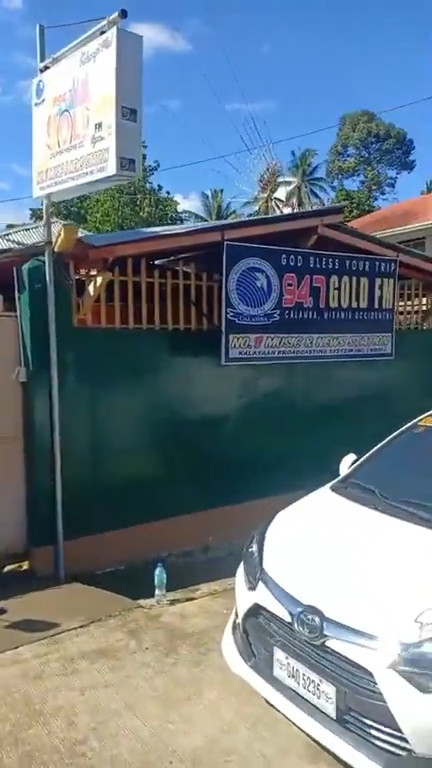
94.7 Gold FM: Calamba is an affiliated local FM radio station of the Kalayaan Broadcasting System Inc. (KBSi), and DJ Johnny Walker played a pivotal role in its success. His morning radio program, 'Pahapyod sa Kabuntagon’ was not only known for its entertaining content but also for its community engagement, discussing local & regional issues in Misamis Occidental, and bringing the community together through various interactive segments. This made Mr. Jumalon, a cherished figure among his listeners and colleagues.
In 2014, his personal broadcasting setup of the aforesaid local FM radio station within a decade before the male suspect gunned down to Mr. Jumalon during an exclusive televised interview of DXTE-TV 8's TV5: Cagayan de Oro for News 5. In his personal health reasons back then, Mr. Jumalon was part of the Persons with Disabilities (PWD). Several years later aside from murder case, local and regional issues to be followed when discussing land and business all across the Misamis Occidental area as a motive.
Per the exclusive spot report as obtained by 106.1mhz’s Favorite Music Radio: Babe Radio Dipolog and the selected KBP-member stations in Misamis Occidental, in cooperation with DWPM-AM’s Radyo 630: Manila, when the tragic incident took place during the said LIVE Facebook video broadcast of 'Pahapyod sa Kabuntagon’ around 5:35am on that fateful Black Sunday. This was the world's first online horrific, TeleRadyo-like broadcasting history in Southern Mindanao.



Outside the CCTV video as mentioned, another suspect to be illegally trespassed, who were pretending in disguise as a local listener for a potential public service without a security guard on-duty.


Within the final moments develop, the unnamed male suspect who remains at large and carries a firearm of caliber .45 pistol, disrupted the live FM radio program and shot twice to Mr. Jumalon (even in audible transistor radio simulcast in general), leading to his untimely demise by shooting his lower lip towards his back portion head, then stealing a gold jewelry worth PHP150,000 (U$D2,682.45), and quickly fled off the scene shortly after. Overall, two or three suspects have yet to be later identified on national internet TV. The aforesaid live video on the radio station’s Facebook page on 94.7 Gold FM: Calamba, captured the horrifying event as it unfolded, leaving online viewers in shock and disbelief.
As we gather a lot of information and investigate the circumstances surrounding this tragic event, there is an outpouring of support and condolences from the listeners, avid fans, friends and colleagues of Mr. Jumalon on various disclosed social media platforms. The incident has prompted discussions about the safety of media professionals, particularly in the realm of live radio broadcasting and online media.
Local authorities in Misamis Occidental have embarked on a detailed probe, and the motive is suspected to be a work-related situation. He was now confirmed dead on arrivial (DOA) from a physician doctor named Dr. Geopeter L. Manisan at Calamba District Hospital (CDH) in National Highway, the said city.
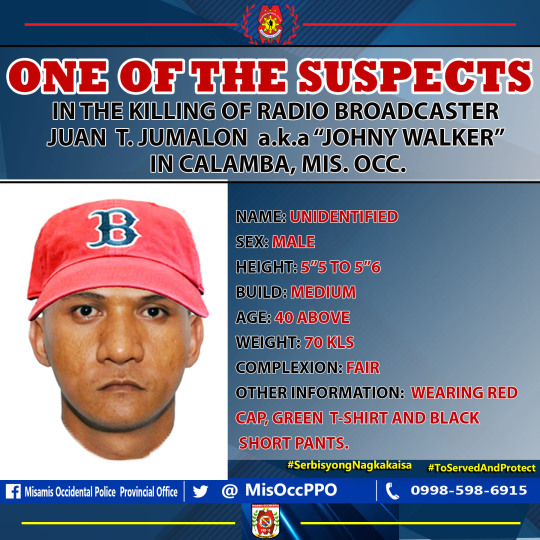

A hot pursuit operation of the Calamba Municipal Police Station (CMPS) is on its way, in relation to a brutal murder suspect from an unidentified gun man.
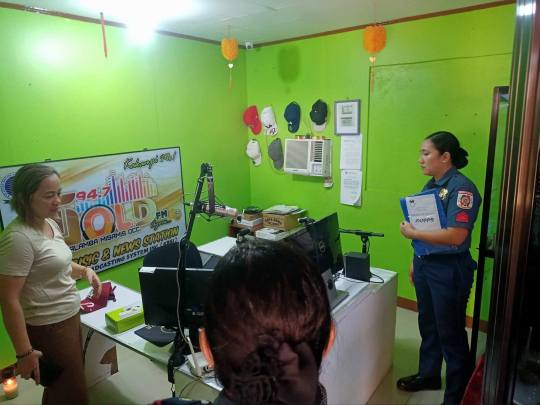
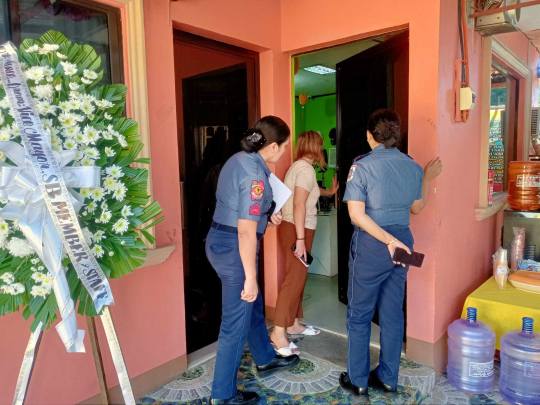
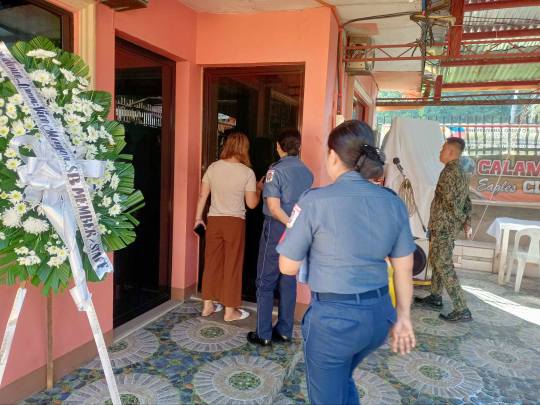
The untimely demise of “DJ Johnny Walker” is a profound loss to the local radio industry and the community he served for several years or decades. His legacy as a passionate radio personality who connected with his audience on a personal level will be remembered and cherished on him. He is one of the 199th journalists killed since 1986 until the present, which includes Central Visayas, Eastern Visayas, Dumaguete City, Mabinay and Negros Oriental, as according to the National Union of Journalists of the Philippines (NUJP).
As the investigation unfolds from the Calamba-Philippine National Police, the community and his fellow broadcasters mourn the loss of a beloved figure and await justice throughout the weekend for this heinous act.
EDITOR's NOTE (as of November 7th, 2023): We edited out for clarification from our previous update, as we all learned from our media friends at Radyo 630: Manila and other KBP-member FM, AM and TV stations in Mindanao to come up with a conclusion.
Amalia Sheran Sharm, Miko Kubota and Ridley Terrance have all fully contributed to this news report.
PHOTO COURTESY for REPRESENTATION: 94.7mhz's Gold FM: Calamba via FB PHOTO BACKGROUND PROVIDED BY: Tegna
SOURCE: *https://www.facebook.com/100064859973484/posts/333407976049356 [Referenced FB News Article via DXJN-FM 105.3mhz's Radyo Bandera News FM: Cotabato] *https://www.facebook.com/100093017771931/videos/356914123385052 [Referenced FB LIVE Video via DXKB-FM 89.3mhz's Radyo Bandera Sweet FM: Cagayan de Oro] *https://www.facebook.com/100077562834152/posts/359801613281930 [Referenced Police Blotter in PR via Arianna Trisha] *https://www.facebook.com/100094088475887/posts/191863797293235 [Referenced FB News Article via DWPM-AM's Radyo 630khz: Manila] *https://www.facebook.com/100075706497836/posts/356802900186590 [Referenced FB News Article via DZMD-FM 100.7mhz's MyFM: Bataan] *https://www.facebook.com/100064616655120/posts/734630538700828 [Referenced FB News Article via The Philippine Star] *https://www.facebook.com/100047471591140/posts/865352015057177 [Referenced FB News Article via Xymon Jeremiah Pedro the 2nd] *https://www.facebook.com/100064282075832/posts/737856285033767 [Referenced FB Captioned Statement Post via Presidential Communications Office] *https://www.philstar.com/headlines/2023/11/05/2309128/misamis-occidental-radio-broadcaster-gunned-down-while-air [Referenced News Article via The Philippine Star] *https://www.facebook.com/100067938276705/posts/669891301952140 [Referenced FB Captioned PHOTO via MOPPO] *https://www.facebook.com/100067938276705/posts/669997835274820 [Referenced FB Captioned PHOTO via MOPPO] *https://www.facebook.com/100064809663843/posts/730885619081754 [Referenced FB Captioned PHOTO via Presidential Task Force on Media Security] *https://www.cnnphilippines.com/regional/2023/11/5/misamis-occidental-juan-jumalon-death.html [Referenced News Article via DXKO-TV 5's CNN Philippines: Cagayan de Oro] *https://pinoytrend.net/2023/11/05/radio-announcer-na-si-johnny-walker-pinatumba-habang-nasa-gitna-ng-kanyang-programa/ [Referenced News Article via PinoyTrend] *https://rmn.ph/radio-announcer-patay-matapos-pagbabarilin-habang-nagpoprograma-sa-calamba-misamis-occidental/ [Referenced News Article via DXDR-AM 981khz's RMN: Dipolog] and *https://remate.ph/radio-broadcaster-binaril-patay-sa-gitna-ng-programa/ [Referenced News Article via Remate]
-- OneNETnews Team
#flash report#national news#calamba#misamis occidental#police report#gunned down#suspect#johnny walker#social media#Gold FM#awareness#OneNETnews
2 notes
·
View notes
Text
01/20/2024 is National Buttercrunch Day 🇺🇸, National Disc Jockey Day 🇺🇸, National Cheese Lovers Day 🧀🇬🇧
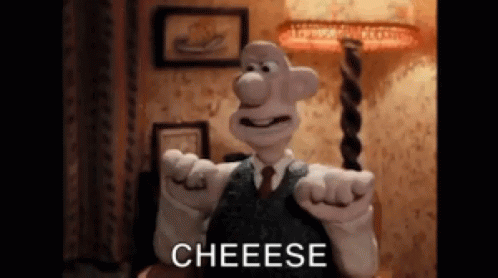
2 notes
·
View notes
Text

ICYMI: Happy National Disc Jockey Day – 2025 + Radio http://dlvr.it/THt8fj
0 notes
Text

Here's something to we can all celebrate! One of my favorite days of the year! #NationalDiscJockeyDay Check out its history: https://www.nationaldaycalendar.com/national-day/national-disc-jockey-day-january-20
#EverythingOldIsNewAgainRadioShow #46thyear #PopStandards #GreatAmericanSongbook #jazzmusic #showtunes #cabaret #broadway
0 notes
Text
Holidays 1.20
Holidays
Armed Forces Day (Mali)
Army Day (Lesotho)
Babin Den (Grandmother’s Day; Bulgaria)
Basketball Day
BBC Democracy Day (UK)
Bill Cosby Sweater Day
Camcorder Day
Day of Deflvders of the Barricades (Barikāžu Aizstāvju Diena; Latvia)
Day of National Mourning (Azerbaijan)
Fiesta de las Corralejas (Sincelejo, Colombia)
Guru Govind Singh Jayanti (India)
Heroes’ Day (Cape Verde, Guinea-Bissau)
Inauguration Day (US) [@4 Years, unless a Sunday]
International Day of Acceptance
International Female Artist Merchandise Appreciation Day
International Hat Day
Joe B. Hall Day (Kentucky)
Lao People’s Armed Forces (Laos)
Martyrs’ Day (Azerbaijan)
Memorial Day of Cyprian Michael Iwene Tansi (Cyprus)
National Charlie Day
National Claudia Day
National Disc Jockey Day (a.k.a. DJ Day)
National 'Good Day' Day
National Judy Day
National Paleontology Day (Peru)
National Sebastian Day
Petlyovden (Rooster Day; Bulgaria)
Roller Coaster Day
Severe Cold begins (Chinese Farmer’s Calendar)
Spurge-Laurel Day (French Republic)
Stay Young Forever Day
Stop! Yield! Day
Take A Walk Outdoors Day
Tamborrada (Drum Festival; Spain)
Tell Them Day
Traffic Rules Day
20th Amendment Ratification Day (US)
Vendors Day (India)
Wannsee Conference Anniversary Day
What’s Going On Day (Michigan)
World Religions Day
Food & Drink Celebrations
National Buttercrunch Day
National Cheese Lover's Day
National Coffee Break Day
World Bigos Day (Poland)
Nature Celebrations
Buttercup (Innocent; Korean Flower Days)
Camel Wrestling Day (Turkey)
National Penguin Day
Shima-Enaga No Hi (Japanese Long-Tailed Tit Day; Japan)
Independence, Flag & Related Days
Dictatorship of Alissia (Declared; 2022) [unrecognized]
Empire of New Europe (Declared; 2009) [unrecognized]
Foundation Day (Rio de Janeiro, Argentina)
Hong Kong (Ceded by China to UK; 1886)
Republic Day (Autonomous Republic of Crimea)
Sprinske Communist Republic (Declared; 2019) [unrecognized]
United Republic of Kwajalein (Declared; 2017) [unrecognized]
Wellington Province Day (New Zealand)
3rd Monday in January
Auld Hansel Monday (Scotland) [Monday after 12th]
Blue Monday (UK) [3rd Monday] (Saddest day of the year)
Brew Monday (UK) [3rd Monday]
Earl Grey Day [3rd Monday]
Elementary School Teacher Day [3rd Monday]
Humanitarian Day [3rd Monday]
Human Relations Day [3rd Monday]
Human Rights Day (Idaho) [3rd Monday]
John Chilembwe Day observed (Malawi) [Monday closest to 1.15]
Junk-Food News Stories Day [3rd Monday]
Manic Monday [3rd Monday of Each Month]
Martin Luther King Jr. Day (a.k.a. MLK Day, King Day) [3rd Monday]
Meatball Monday [3rd Monday of Each Month]
Meditation Monday [Every Monday]
Monday Musings [Every Monday]
Motivation Monday [Every Monday]
National Crowd Feed Day [3rd Monday]
National Day of Service [3rd Monday]
National Pothole Day (UK) [Closest Weekday to 15th]
Robert E. Lee Day (Alabama, Arkansas, Mississippi) [3rd Monday]
Weekly Holidays beginning January 20 (3rd Full Week of January)
Cancertalk Week (UK) [thru 1.24]
Clayton Restaurant Week (Clayton, Missouri) [thru 1.26]
Energy Savers Week [thru 1.26]
European Cervical Canver Prevention Week [thru 1.26]
National Thrift Week [3rd Week]
No Name Calling Week (thru 1.24) [3rd Week]
Sugar Awareness Week [3rd Week]
Winter Restaurants & Craft Beverages Weeks (Howard County, Maryland) [thru 2.2]
Festivals Beginning January 20, 2025
Ati-Atihan Festival (Kalibo, Aklan, Philippines) [thru 1.27]
College Football National Championship Game (Atlanta, Georgia)
Corralejas Bullfighting Festival (Sincelejo, Colombia)
International Snow Sculpture Championshiop [thru 1.29]
Nosso Senhor Do Bonfim Festival, a.k.. Our Lord of the Happy Ending Festival (Salvador, Bahia, Brazil) [thru 1.30]
Tamborrada Drum Festival (San Sebastián, Spain)
Feast Days
Abadios (Christian; Saint)
Avalon, The Island of Apples (Celtic Book of Days)
Baba Yaga Day (Starza Pagan Book of Days)
Blessed Basil Moreau (Christian; Saint)
Corralejas Festival (Fiesta de las Corralejas; Colombia)
Cyprian Michael Irene Tansi (Christian; Saint)
Eustochia Smeralda Calafato (Christian; Saint)
Euthymius the Great (Christian; Saint)
Eve of Saint Agnes [Virgins]
Fabian (Roman Catholic; Saint)
Fechin (Christian; Saint)
Feralia: Day of Purification (Pagan)
Festival of Jubilation for Osiris (Egyptian God of Agriculture)
John the Baptist Day (Serbia)
Manchán of Lemanaghan (Christian; Saint)
Mano-Capac (Positivist; Saint)
Maria Cristina of the Immaculate Conception Brando (Christian)
Marx Brothers Quote Day (Pastafarian)
Mr. Between (Muppetism)
Richard Rolle (Church of England)
Sacrifices to Athena (Ancient Greece)
Sebastian (Christian; Martyr)
Stephen Min Kuk-ka (one of The Korean Martyrs)
Tiny Tim Day (Church of the SubGenius; Saint)
Lunar Calendar Holidays
Chinese: Month 12 (Ding-Chou), Day 21 (Ji-Chou)
Day Pillar: Earth Ox
12-Day Officers/12 Gods: Establish Day (建 Jian) [Inauspicious]
Holidays:
Great Cold
Hebrew Calendar Holidays [Begins at Sundown]
Hebrew Language Day [20-21 Teveth]
Secular Saints Days
Joy Adamson (Conservation)
Buzz Aldrin (Science)
Andre-Marie Ampere (Science)
Dorothy Annan (Art)
Tom Baker (Entertainment)
Hippolyte Bayard (Art)
Lead Belly (Music)
George Burns (Entertainment)
Robert Olen Butler (Literature)
Clarice Cliff (Art)
Federico Fellini (Entertainment)
Harold Gray (Art)
johannes V. Jensen (Literature)
DeForrest Kelley (Entertainment)
Richard Henry Lee (Politics)
David Lynch (Entertainment)
Questlove (Music)
Mark Ryden (Art)
Lucky & Unlucky Days
Blue Monday (UK) [3rd Monday] (Saddest day of the year)
Tomobiki (友引 Japan) [Good luck all day, except at noon.]
Unfortunate Day (Pagan) [6 of 57]
Premieres
Ah, Sweet Mouse-Story of Life (Tom & Jerry Cartoon; 1965)
The Artist (Film; 2012)
Awkwafina is Nora from Queens (TV Series; 2020)
Blood on the Tracks, by Bob Dylan (Album; 1975)
Born Free, by Joy Adamson (Novel; 1960)
Breaking Bad (TV Series; 2008)
Buick Riviera (Automobile; 1949)
The Caine Mutiny Court Martial, by Herman Wouk (Play; 1954)
Cat and Dupli-Cat (Tom & Jerry Cartoon; 1967)
Changes in Latitudes, Changes in Attitudes, by Jimmy Buffet (Album; 1977)
CIA [Central Intelligence Agency] (US Gov’t Agency; 1946)
Dawson’s Creek (TV Series; 1998)
Die Drei Pintos, by Carl Maria von Weber (Opera; 1888)
Die Opernprobe, by Albert Lortzing (Opera; 1851)
Duel Personality (Tom & Jerry Cartoon; 1966)
Ecstasy (Film; 1933)
The Fishing Bear, featuring Barney Bear (MGM Cartoon; 1940)
The Founder (Film; 2017)
A Fox in a Fix (WB MM Cartoon; 1951)
Fullmetal Alchemist: The Sacred Star of Milos (Animated Film; 2012)
Get a Job, by The Silhouettes (Song; 1958)
High School Musical (TV Movie; 2006)
Homework, by Daft Punk (Album; 1997)
in Old Arizona (Film; 1929)
Leaf by Niggle, by J.R.R. Tolkien (Short Story; 1945)
Lion Around (Disney Cartoon; 1950)
London Docks (Trade Area; UK; 1805)
Maximum Tazocity (WB Cartoon; 2005)
Meet the Beatles!, by The Beatles (Album; 1964)
Murdoch Mysteries (TV Series; 2008)
Noble Beast, by Andrew Bird (Album; 2009)
Pyromania, by Def Leppard (Album; 1983)
Red Tails (Film; 2012)
The Red Turtle (Animated Film; 2017)
Tristram Shandy (Film; 2006)
Tuck Everlasting, by Natalie Babbitt (Novel; 1975)
Underworld: Awakening (Film; 2012)
Wet Hare (WB LT Cartoon; 1962)
What a Fool Believes, by the Doobie Brothers (Song; 1979)
What’s Going On, by Marvin Gaye (Song; 1971)
When You Finish Saving the World (Film; 2023)
Why We Fight (Documentary Film; 2006)
Wuthering Heights, by Kate Bush (Song; 1978)
xXx: The Return of Xander Cage (Film; 2017)
Today’s Name Days
Fabianus, Sebastian, Ursula, Ute (Austria)
Efimir, Evtim, Evtimiya, Momchil (Bulgaria)
Fabijan, Sebastijan (Croatia)
Ilona (Czech Republic)
Fabian, Sebastian (Denmark)
Hendrika, Henna, Henni, Henriette, Jete (Estonia)
Sebastian (Finland)
Fabien, Sébastien (France)
Fabian, Paula, Sebastian, Ursula (Germany)
Evthymios, Fabianos, Thymios (Greece)
Fábián, Sebestyén (Hungary)
Fabiano, Sebastiano, Teodorico (Italy)
Algirts, Oļģerts (Latvia)
Daugvydas, Fabijonas, Sebastijonas (Lithuania)
Bastian, Fabian, Sebastian (Norway)
Dobiegniew, Fabian, Sebastian (Poland)
Eftimie (Romania)
Dalibor (Slovakia)
Enrique, Fabián, Sebastián (Spain)
Fabian, Sebastian (Sweden)
Fabia, Fabian, Fabiola, Sebastian, Sebastiana (USA)
Today is Also…
Day of Year: Day 20 of 2025; 345 days remaining in the year
ISO: Day 1 of Week 4 of 2025
Celtic Tree Calendar:
Druid Tree Calendar: Elm (Jan 12-24) [Day 9 of 13]
Graves Calendar: Beth (Birch) [Day 28 of 28]
Chinese: Month 12 (Ding-Chou), Day 21 (Ji-Chou)
Chinese Year of the: Dragon 4722 (until January 29, 2025) [Wu-Chen]
Coptic: 12 Tubah 1741
Hebrew: 20 Teveth 5785
Islamic: 20 Rajab 1446
J Cal: 20 White; Sixthday [20 of 30]
Julian: 7 January 2025
Moon: 61%: Waning Gibbous
Positivist: 20 Moses (1st Month) [Mano-Capac]
Runic Half Month: Peorth (Womb, Dice Cup) [Day 14 of 15]
Season: Winter (Day 31 of 90)
Week: 3rd Full Week of January
Zodiac:
Tropical (Typical) Zodiac: Aquarius (Day 1 of 30)
Sidereal Zodiac: Capricorn (Day 6 of 29)
Schmidt Zodiac: Sagittarius (Day 20 of 25)
IAU Boundaries (Current) Zodiac: Sagittarius (Day 36 of 36) / Capricorn (Day 1 of 28)
IAU Boundaries (1977) Zodiac: Capricornus (Day 2 of 28)
0 notes
Text
Holidays 1.20
Holidays
Armed Forces Day (Mali)
Army Day (Lesotho)
Babin Den (Grandmother’s Day; Bulgaria)
Basketball Day
BBC Democracy Day (UK)
Bill Cosby Sweater Day
Camcorder Day
Day of Deflvders of the Barricades (Barikāžu Aizstāvju Diena; Latvia)
Day of National Mourning (Azerbaijan)
Fiesta de las Corralejas (Sincelejo, Colombia)
Guru Govind Singh Jayanti (India)
Heroes’ Day (Cape Verde, Guinea-Bissau)
Inauguration Day (US) [@4 Years, unless a Sunday]
International Day of Acceptance
International Female Artist Merchandise Appreciation Day
International Hat Day
Joe B. Hall Day (Kentucky)
Lao People’s Armed Forces (Laos)
Martyrs’ Day (Azerbaijan)
Memorial Day of Cyprian Michael Iwene Tansi (Cyprus)
National Charlie Day
National Claudia Day
National Disc Jockey Day (a.k.a. DJ Day)
National 'Good Day' Day
National Judy Day
National Paleontology Day (Peru)
National Sebastian Day
Petlyovden (Rooster Day; Bulgaria)
Roller Coaster Day
Severe Cold begins (Chinese Farmer’s Calendar)
Spurge-Laurel Day (French Republic)
Stay Young Forever Day
Stop! Yield! Day
Take A Walk Outdoors Day
Tamborrada (Drum Festival; Spain)
Tell Them Day
Traffic Rules Day
20th Amendment Ratification Day (US)
Vendors Day (India)
Wannsee Conference Anniversary Day
What’s Going On Day (Michigan)
World Religions Day
Food & Drink Celebrations
National Buttercrunch Day
National Cheese Lover's Day
National Coffee Break Day
World Bigos Day (Poland)
Nature Celebrations
Buttercup (Innocent; Korean Flower Days)
Camel Wrestling Day (Turkey)
National Penguin Day
Shima-Enaga No Hi (Japanese Long-Tailed Tit Day; Japan)
Independence, Flag & Related Days
Dictatorship of Alissia (Declared; 2022) [unrecognized]
Empire of New Europe (Declared; 2009) [unrecognized]
Foundation Day (Rio de Janeiro, Argentina)
Hong Kong (Ceded by China to UK; 1886)
Republic Day (Autonomous Republic of Crimea)
Sprinske Communist Republic (Declared; 2019) [unrecognized]
United Republic of Kwajalein (Declared; 2017) [unrecognized]
Wellington Province Day (New Zealand)
3rd Monday in January
Auld Hansel Monday (Scotland) [Monday after 12th]
Blue Monday (UK) [3rd Monday] (Saddest day of the year)
Brew Monday (UK) [3rd Monday]
Earl Grey Day [3rd Monday]
Elementary School Teacher Day [3rd Monday]
Humanitarian Day [3rd Monday]
Human Relations Day [3rd Monday]
Human Rights Day (Idaho) [3rd Monday]
John Chilembwe Day observed (Malawi) [Monday closest to 1.15]
Junk-Food News Stories Day [3rd Monday]
Manic Monday [3rd Monday of Each Month]
Martin Luther King Jr. Day (a.k.a. MLK Day, King Day) [3rd Monday]
Meatball Monday [3rd Monday of Each Month]
Meditation Monday [Every Monday]
Monday Musings [Every Monday]
Motivation Monday [Every Monday]
National Crowd Feed Day [3rd Monday]
National Day of Service [3rd Monday]
National Pothole Day (UK) [Closest Weekday to 15th]
Robert E. Lee Day (Alabama, Arkansas, Mississippi) [3rd Monday]
Weekly Holidays beginning January 20 (3rd Full Week of January)
Cancertalk Week (UK) [thru 1.24]
Clayton Restaurant Week (Clayton, Missouri) [thru 1.26]
Energy Savers Week [thru 1.26]
European Cervical Canver Prevention Week [thru 1.26]
National Thrift Week [3rd Week]
No Name Calling Week (thru 1.24) [3rd Week]
Sugar Awareness Week [3rd Week]
Winter Restaurants & Craft Beverages Weeks (Howard County, Maryland) [thru 2.2]
Festivals Beginning January 20, 2025
Ati-Atihan Festival (Kalibo, Aklan, Philippines) [thru 1.27]
College Football National Championship Game (Atlanta, Georgia)
Corralejas Bullfighting Festival (Sincelejo, Colombia)
International Snow Sculpture Championshiop [thru 1.29]
Nosso Senhor Do Bonfim Festival, a.k.. Our Lord of the Happy Ending Festival (Salvador, Bahia, Brazil) [thru 1.30]
Tamborrada Drum Festival (San Sebastián, Spain)
Feast Days
Abadios (Christian; Saint)
Avalon, The Island of Apples (Celtic Book of Days)
Baba Yaga Day (Starza Pagan Book of Days)
Blessed Basil Moreau (Christian; Saint)
Corralejas Festival (Fiesta de las Corralejas; Colombia)
Cyprian Michael Irene Tansi (Christian; Saint)
Eustochia Smeralda Calafato (Christian; Saint)
Euthymius the Great (Christian; Saint)
Eve of Saint Agnes [Virgins]
Fabian (Roman Catholic; Saint)
Fechin (Christian; Saint)
Feralia: Day of Purification (Pagan)
Festival of Jubilation for Osiris (Egyptian God of Agriculture)
John the Baptist Day (Serbia)
Manchán of Lemanaghan (Christian; Saint)
Mano-Capac (Positivist; Saint)
Maria Cristina of the Immaculate Conception Brando (Christian)
Marx Brothers Quote Day (Pastafarian)
Mr. Between (Muppetism)
Richard Rolle (Church of England)
Sacrifices to Athena (Ancient Greece)
Sebastian (Christian; Martyr)
Stephen Min Kuk-ka (one of The Korean Martyrs)
Tiny Tim Day (Church of the SubGenius; Saint)
Lunar Calendar Holidays
Chinese: Month 12 (Ding-Chou), Day 21 (Ji-Chou)
Day Pillar: Earth Ox
12-Day Officers/12 Gods: Establish Day (建 Jian) [Inauspicious]
Holidays:
Great Cold
Hebrew Calendar Holidays [Begins at Sundown]
Hebrew Language Day [20-21 Teveth]
Secular Saints Days
Joy Adamson (Conservation)
Buzz Aldrin (Science)
Andre-Marie Ampere (Science)
Dorothy Annan (Art)
Tom Baker (Entertainment)
Hippolyte Bayard (Art)
Lead Belly (Music)
George Burns (Entertainment)
Robert Olen Butler (Literature)
Clarice Cliff (Art)
Federico Fellini (Entertainment)
Harold Gray (Art)
johannes V. Jensen (Literature)
DeForrest Kelley (Entertainment)
Richard Henry Lee (Politics)
David Lynch (Entertainment)
Questlove (Music)
Mark Ryden (Art)
Lucky & Unlucky Days
Blue Monday (UK) [3rd Monday] (Saddest day of the year)
Tomobiki (友引 Japan) [Good luck all day, except at noon.]
Unfortunate Day (Pagan) [6 of 57]
Premieres
Ah, Sweet Mouse-Story of Life (Tom & Jerry Cartoon; 1965)
The Artist (Film; 2012)
Awkwafina is Nora from Queens (TV Series; 2020)
Blood on the Tracks, by Bob Dylan (Album; 1975)
Born Free, by Joy Adamson (Novel; 1960)
Breaking Bad (TV Series; 2008)
Buick Riviera (Automobile; 1949)
The Caine Mutiny Court Martial, by Herman Wouk (Play; 1954)
Cat and Dupli-Cat (Tom & Jerry Cartoon; 1967)
Changes in Latitudes, Changes in Attitudes, by Jimmy Buffet (Album; 1977)
CIA [Central Intelligence Agency] (US Gov’t Agency; 1946)
Dawson’s Creek (TV Series; 1998)
Die Drei Pintos, by Carl Maria von Weber (Opera; 1888)
Die Opernprobe, by Albert Lortzing (Opera; 1851)
Duel Personality (Tom & Jerry Cartoon; 1966)
Ecstasy (Film; 1933)
The Fishing Bear, featuring Barney Bear (MGM Cartoon; 1940)
The Founder (Film; 2017)
A Fox in a Fix (WB MM Cartoon; 1951)
Fullmetal Alchemist: The Sacred Star of Milos (Animated Film; 2012)
Get a Job, by The Silhouettes (Song; 1958)
High School Musical (TV Movie; 2006)
Homework, by Daft Punk (Album; 1997)
in Old Arizona (Film; 1929)
Leaf by Niggle, by J.R.R. Tolkien (Short Story; 1945)
Lion Around (Disney Cartoon; 1950)
London Docks (Trade Area; UK; 1805)
Maximum Tazocity (WB Cartoon; 2005)
Meet the Beatles!, by The Beatles (Album; 1964)
Murdoch Mysteries (TV Series; 2008)
Noble Beast, by Andrew Bird (Album; 2009)
Pyromania, by Def Leppard (Album; 1983)
Red Tails (Film; 2012)
The Red Turtle (Animated Film; 2017)
Tristram Shandy (Film; 2006)
Tuck Everlasting, by Natalie Babbitt (Novel; 1975)
Underworld: Awakening (Film; 2012)
Wet Hare (WB LT Cartoon; 1962)
What a Fool Believes, by the Doobie Brothers (Song; 1979)
What’s Going On, by Marvin Gaye (Song; 1971)
When You Finish Saving the World (Film; 2023)
Why We Fight (Documentary Film; 2006)
Wuthering Heights, by Kate Bush (Song; 1978)
xXx: The Return of Xander Cage (Film; 2017)
Today’s Name Days
Fabianus, Sebastian, Ursula, Ute (Austria)
Efimir, Evtim, Evtimiya, Momchil (Bulgaria)
Fabijan, Sebastijan (Croatia)
Ilona (Czech Republic)
Fabian, Sebastian (Denmark)
Hendrika, Henna, Henni, Henriette, Jete (Estonia)
Sebastian (Finland)
Fabien, Sébastien (France)
Fabian, Paula, Sebastian, Ursula (Germany)
Evthymios, Fabianos, Thymios (Greece)
Fábián, Sebestyén (Hungary)
Fabiano, Sebastiano, Teodorico (Italy)
Algirts, Oļģerts (Latvia)
Daugvydas, Fabijonas, Sebastijonas (Lithuania)
Bastian, Fabian, Sebastian (Norway)
Dobiegniew, Fabian, Sebastian (Poland)
Eftimie (Romania)
Dalibor (Slovakia)
Enrique, Fabián, Sebastián (Spain)
Fabian, Sebastian (Sweden)
Fabia, Fabian, Fabiola, Sebastian, Sebastiana (USA)
Today is Also…
Day of Year: Day 20 of 2025; 345 days remaining in the year
ISO: Day 1 of Week 4 of 2025
Celtic Tree Calendar:
Druid Tree Calendar: Elm (Jan 12-24) [Day 9 of 13]
Graves Calendar: Beth (Birch) [Day 28 of 28]
Chinese: Month 12 (Ding-Chou), Day 21 (Ji-Chou)
Chinese Year of the: Dragon 4722 (until January 29, 2025) [Wu-Chen]
Coptic: 12 Tubah 1741
Hebrew: 20 Teveth 5785
Islamic: 20 Rajab 1446
J Cal: 20 White; Sixthday [20 of 30]
Julian: 7 January 2025
Moon: 61%: Waning Gibbous
Positivist: 20 Moses (1st Month) [Mano-Capac]
Runic Half Month: Peorth (Womb, Dice Cup) [Day 14 of 15]
Season: Winter (Day 31 of 90)
Week: 3rd Full Week of January
Zodiac:
Tropical (Typical) Zodiac: Aquarius (Day 1 of 30)
Sidereal Zodiac: Capricorn (Day 6 of 29)
Schmidt Zodiac: Sagittarius (Day 20 of 25)
IAU Boundaries (Current) Zodiac: Sagittarius (Day 36 of 36) / Capricorn (Day 1 of 28)
IAU Boundaries (1977) Zodiac: Capricornus (Day 2 of 28)
1 note
·
View note
Text
HJS - again in writing (in all things and any) her literary style makes me melt.
this is her academic introduction dep. English Vanderbilt University:
https://as.vanderbilt.edu/english/bio/hortense-spillers/
Having taught in the U.S. academy for three decades now (and counting), I am reluctant to look back for all those mythical reasons that warn against the backward glance. (I never figured out why doing so might turn one into a pillar of salt, but it is alleged from quite reputable sources to have happened to at least one person!) In any case, when I conjure up 1974, when I started post-doc teaching at Wellesley College, I always find something to cut the memory short, since remembering is to suggest that you have more past than future, but it doesn’t feel so to me at all. Actually, I feel as though I’m just getting started good! Though I think I wouldn’t have been half bad at either, I am nevertheless grateful to myself that I didn’t pursue a career in the practice of law, or tv/radio broadcasting, having spent my last two years in undergraduate school at the University of Memphis as a disc jockey at WDIA radio in Memphis. This historic organization—among the first, if not the dead absolute first, all-black radio station in the United States—might have been my launching pad, I’d hoped, to a career in national news; as I recall, I was preparing to take the broadcasters’ examination, administered by the Feds (and the equivalent of our SATs, or in those days, CEEBs) and about to cut a tape, at their request, to post to the executives who ran WHER in Memphis—the first all-woman radio station in the country, I think. But after all that, William Blake’s prophetic books won the charm offensive! Is that not a surprise, or what! Not many things were more interesting to me then than Walter Cronkite, Pauline Fredrick, and Edward R. Morrow, unless it was “Vala, or the Four Zoas”! And one thing led to another and another and finally a career of literary and cultural interrogation that has taken me literally from my birthplace on the southern tier to the East and Mid-West of the country and several decades later, back again. It would be an understatement to assert that it is not today the same South from which I departed my parents’ driveway in my little Buick Skylark, three months after MLK’s assassination, enroute to Boston and Brandeis. The changes have been momentous for everyone and precisely frame my own professional development.
Try to imagine this: I hired someone to type my doctoral dissertation, though I was competent enough to have done it myself. But one hired out the work before computers because the professional typist was expected to be very fast, very capable, and expert at the proper formatting. You did everything else. The distance that separates the mid-70s from the turn-of-the-century world is a matter of light years, but I wonder how we are doing today with an old-fashioned aim in mind, and that is to say, teaching reading and writing in the age of twitter, although we apply far fancier names to what we do. It is likely that I wrote my dissertation on the rhetoric of black sermons by hand first, then made a rough copy of it on my Olivetti, then gave the secretary the rough draft from which to make the perfect draft. I think I paid the lady $200.00 and change, as the first “real” painting I bought from the same era—a striking head of Miles Davis on a black ground-- cost five hundred. Living in Haverford rather than Philly, Ithaca rather than the Big Apple, not taking a job in Chicago, but staying in central New York, I survived the 80s, 90s, and the new millennium; what bothers me now is that we haven’t figured out yet the implications of inflated costs, e.g;, that of higher education and the speeds that are supposed to match the global flows of capital. I think we need to spend a little time trying to imagine what all the latter mean to and for the tasks of higher education.
0 notes
Text

#DJMonday Sometimes, disc jockeys doubled as sports announcers. At KFH (AM) in Wichita, Kansas, these unidentified gentlemen dressed appropriately for an all-night broadcast of the National Semi-Pro Baseball tournament. "Elimination games were played all in one day, all night, and all the next day on the opening day of the Semi-Pro Baseball tournament," according to the caption on the back of the photo (undated).
Special Collections in Mass Media and Culture | Tumblr Archive
2 notes
·
View notes